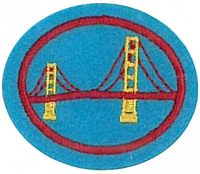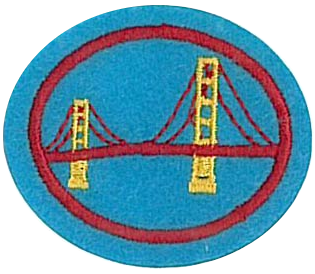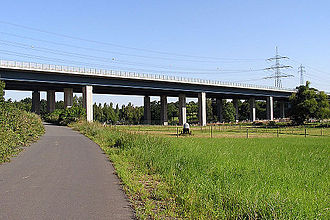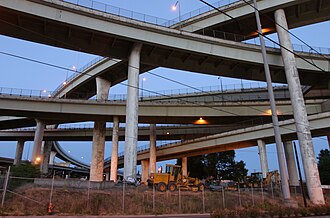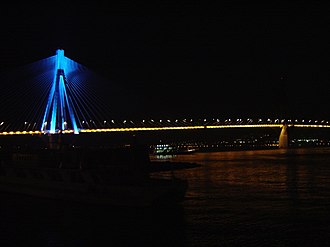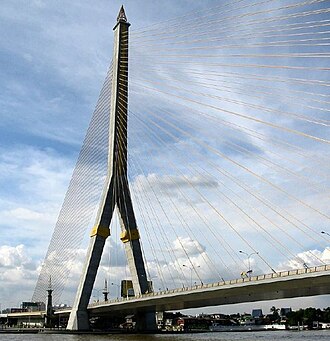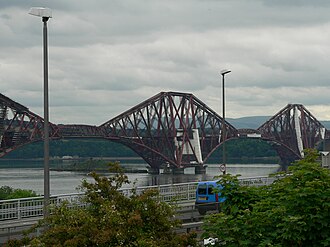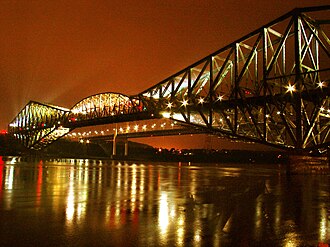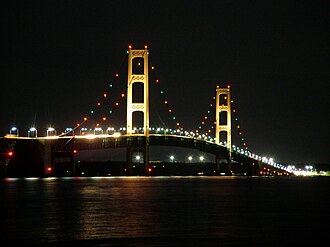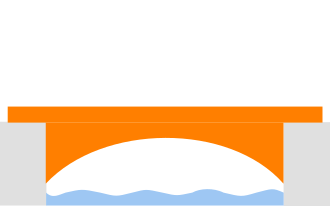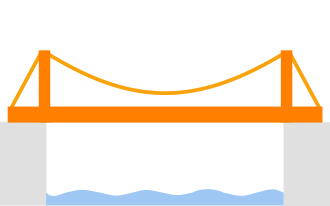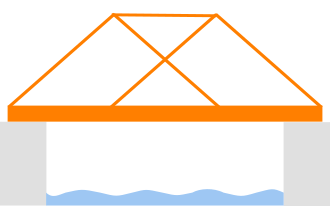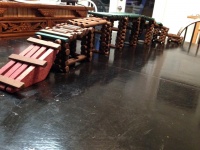Difference between revisions of "AY Honors/Bridges/Answer Key/es"
(Created page with "Libro de Respuestas de Especialidades JA/Artes y Habilidades Manuales/Puentes") |
(Updating to match new version of source page) |
||
| (119 intermediate revisions by 3 users not shown) | |||
| Line 1: | Line 1: | ||
| − | < | + | {{HonorSubpage}} |
| + | <section begin="Body" /> | ||
| + | {{ansreq|page={{#titleparts:{{PAGENAME}}|2|1}}|num=1}} | ||
<noinclude></noinclude> | <noinclude></noinclude> | ||
| − | {{ | + | <!-- 1. Definir los siguientes términos: --> |
| − | | | + | <noinclude></noinclude> |
| − | | | + | {{ansreq|page={{#titleparts:{{PAGENAME}}|2|1}}|num=1a}} |
| − | | | + | <noinclude></noinclude> |
| − | | | + | Una estructura construida para atravesar un valle, camino o ferrocarril, cuerpo de agua u otro obstáculo físico, con el propósito de proveer el paso sobre el obstáculo. |
| − | |||
| − | |||
| − | |||
| − | |||
| − | == | + | <noinclude></noinclude> |
| − | + | {{CloseReq}} <!-- 1a --> | |
| + | {{ansreq|page={{#titleparts:{{PAGENAME}}|2|1}}|num=1b}} | ||
| + | <noinclude></noinclude> | ||
| + | Un puente que lleva agua. Popular antes de que tuviéramos bombas eléctricas. Varias [[esw:Acueducto|fotos interesantes aquí]]. | ||
| + | [[Image:MonroeStreetBridgea.jpg|right|thumb|550px|Cimbra centrado en el arco central del puente de la calle de Monroe, en Spokane, Washington. 1911.]] | ||
| − | + | <noinclude></noinclude> | |
| − | + | {{CloseReq}} <!-- 1b --> | |
| − | + | {{ansreq|page={{#titleparts:{{PAGENAME}}|2|1}}|num=1c}} | |
| − | + | <noinclude></noinclude> | |
| − | + | El andamio de soporte temporal utilizado durante la construcción de algunos tipos de puentes. | |
| − | + | <noinclude></noinclude> | |
| + | {{CloseReq}} <!-- 1c --> | ||
| + | {{ansreq|page={{#titleparts:{{PAGENAME}}|2|1}}|num=1d}} | ||
| + | <noinclude></noinclude> | ||
| + | La presión hacia abajo (generalmente vertical) que se aplica a las columnas de soporte de un diseño de puente por el peso de los materiales del puente, así como la carga de tráfico que está en el puente. | ||
| + | <noinclude></noinclude> | ||
| + | {{CloseReq}} <!-- 1d --> | ||
| + | {{ansreq|page={{#titleparts:{{PAGENAME}}|2|1}}|num=1e}} | ||
| + | <noinclude></noinclude> | ||
| + | La fuerza de apriete o tracción (normalmente horizontal o en un ángulo distinto de vertical) que ayuda a estabilizar el diseño de un puente y transfiere la fuerza de compresión a los soportes del diseño de un puente. | ||
| + | <noinclude></noinclude> | ||
| + | {{CloseReq}} <!-- 1e --> | ||
| + | {{ansreq|page={{#titleparts:{{PAGENAME}}|2|1}}|num=1f}} | ||
| + | <noinclude></noinclude> | ||
| + | Un puente móvil con un contrapeso que equilibra continuamente el tramo a lo largo de todo el recorrido ascendente para proporcionar espacio libre para el tráfico de barcos. Son el tipo más común de puente móvil en existencia porque se abren rápidamente y requieren relativamente poca energía para operar. Bascule es una palabra en francés. En español esto generalmente se llama un puente levadizo. | ||
[[Image:MovableBridge_draw.gif]] | [[Image:MovableBridge_draw.gif]] | ||
| − | + | <noinclude></noinclude> | |
| + | {{CloseReq}} <!-- 1f --> | ||
| + | {{ansreq|page={{#titleparts:{{PAGENAME}}|2|1}}|num=1g}} | ||
| + | <noinclude></noinclude> | ||
| + | Una estructura con lados cerrados y un techo que a menudo tiene sólo un carril, y típicamente está hecho de madera. Como los puentes de madera tendían a deteriorarse rápidamente por la exposición a los elementos, sólo tenían una vida útil de nueve años. Cubrirlos protegía a sus miembros estructurales, extendiendo así su vida a 80 años o más. Cubrirlos también eliminaba la necesidad de barrer la nieve durante o después de las tormentas de nieve. | ||
| + | [[Image:Buchfart_-_Alte_Holzbr%C3%BCcke_1613_%C3%BCber_die_Ilm.jpg|200px|Buchfart - Alte Holzbrücke 1613]] | ||
| + | |||
| + | <noinclude></noinclude> | ||
| + | {{CloseReq}} <!-- 1g --> | ||
| + | {{CloseReq}} <!-- 1 --> | ||
| + | {{ansreq|page={{#titleparts:{{PAGENAME}}|2|1}}|num=2}} | ||
| + | <noinclude></noinclude> | ||
| + | <!-- 2. Describir los seis tipos principales de diseño de puentes y dar dos ejemplos de cada uno: --> | ||
| + | <noinclude></noinclude> | ||
| + | {{ansreq|page={{#titleparts:{{PAGENAME}}|2|1}}|num=2a}} | ||
| + | <noinclude></noinclude> | ||
| − | + | [[File:Bridge Alcantara.JPG|thumb|300px|Puente Alcantara]] | |
| − | |||
| − | + | Puentes en forma de arco con pilares en cada extremo. Los puentes en arco funcionan transfiriendo el peso del puente y sus cargas parcialmente a un empuje horizontal restringido por los contrafuertes a cada lado. Un viaducto (un puente largo) se puede hacer a partir de una serie de arcos, aunque otras estructuras más económicas se utilizan normalmente para abarcar una gran distancia en la actualidad. | |
| − | + | Los mayores constructores de puentes de la antigüedad fueron los antiguos romanos. Los romanos construyeron puentes de arco y acueductos que podrían soportar condiciones que dañarían o destruirían diseños anteriores. Un ejemplo de uno que todavía está parado hoy es el puente de Alcantara en España. | |
| − | |||
| − | + | Los primeros puentes de arco conocidos fueron construidos por los griegos e incluyen el Puente Arkadiko. | |
| − | + | Dubái, en los Emiratos Árabes Unidos, está construyendo actualmente el puente Jeque Rashid bin Saeed. Cuando esté terminado, será el puente de arco más grande del mundo. | |
| − | {{clear}} | + | {{clear}}</noinclude> |
| − | == | + | {{CloseReq}} <!-- 2a --> |
| − | [[File:Bundesautobahn 5 Urselbachtal.jpg|thumb|300px| | + | {{ansreq|page={{#titleparts:{{PAGENAME}}|2|1}}|num=2b}} <!--T:8--> |
| − | [[File:FremontBridgeApproach.jpg|thumb|300px| | + | <noinclude></noinclude> |
| + | [[File:Bundesautobahn 5 Urselbachtal.jpg|thumb|300px|Puente viga en Alemania]] | ||
| + | [[File:FremontBridgeApproach.jpg|thumb|300px|Las rampas de acceso al norte del Puente Frémont donde se cruza con la Interestatal 5.]] | ||
| − | + | Un puente de vigas es el tipo de puente más simple hoy en día. Los primeros puentes de vigas eran simples troncos que se encontraban en corrientes y estructuras simples similares. En los tiempos modernos, los puentes de vigas se fabrican con mayor frecuencia a partir de vigas en «I» de acero poco profundas, vigas cajoneras, hormigón armado o hormigón potenzado. | |
| − | + | Al igual que la mayoría de los puentes que se caracterizan por la forma en que se soportan, los puentes de vigas consisten en una viga horizontal con 2 soportes, generalmente en cada extremo. El peso en la parte superior de la viga empuja hacia abajo sobre los muelles en cada extremo del puente. | |
| − | + | Los ejemplos incluyen la mayoría de los pasos a desnivel de autopistas y cualquier puente de troncos. | |
{{clear}} | {{clear}} | ||
| − | == | + | <noinclude></noinclude> |
| − | [[File:The amazing bridge that spans the Yangtze River-edit.jpg|thumb|300px|Sutong | + | {{CloseReq}} <!-- 2b --> |
| − | [[File:Antirio | + | {{ansreq|page={{#titleparts:{{PAGENAME}}|2|1}}|num=2c}} <!--T:12--> |
| − | [[File:Rama VIII Bridge, Thailand-edit.jpg|thumb|300px|Rama VIII | + | <noinclude></noinclude> |
| + | [[File:The amazing bridge that spans the Yangtze River-edit.jpg|thumb|300px|Puente Sutong sobre el río Yangtze]] | ||
| + | [[File:Rio Antirio dsc06353.jpg|thumb|300px|Puente Rio-Antirio en Greece (forma de abanico)]] | ||
| + | [[File:Rama VIII Bridge, Thailand-edit.jpg|thumb|300px|Punete Rama VIII en Thailandia (forma de arpa)]] | ||
| − | + | Un puente que consta de una o más columnas (normalmente denominadas torres o torres de alta tensión), con cables que soportan la cubierta del puente. Al igual que los puentes colgantes, los puentes atirantados se sujetan con cables. Sin embargo, en un puente atirantado, se requiere menos cables y las torres que sostienen los cables son proporcionalmente más cortas. El primer puente atirantado conocido fue diseñado en 1784 por C. T. Loescher. | |
| − | + | El 12 de abril de 2013, el puente Russky en Vladivostok, Rusia con su tramo de 1.104 metros reemplazó el puente Sutong sobre el río Yangtze en China como el puente atirantado más largo del mundo. | |
| − | + | El segundo o tercer puente atirantado más largo en el hemisferio occidental es el Puente Port Mann cerca de Vancouver, Columbia Británica. Con 10 carriles (65 m de ancho) es el puente de largo alcance más ancho del mundo de cualquier tipo. | |
| − | + | {{clear}} | |
| − | |||
{{clear}} | {{clear}} | ||
| − | == | + | <noinclude></noinclude> |
| − | [[File:Forth bridges 2005-06-17 04.jpg|thumb|300px|Forth | + | {{CloseReq}} <!-- 2c --> |
| − | [[File:Photo 149.jpg|thumb|300px|Quebec | + | {{ansreq|page={{#titleparts:{{PAGENAME}}|2|1}}|num=2d}} <!--T:18--> |
| − | + | <noinclude></noinclude> | |
| + | [[File:Forth bridges 2005-06-17 04.jpg|thumb|300px|Puente de Forth]] | ||
| + | [[File:Photo 149.jpg|thumb|300px|Puente de Quebec, en Quebec, Canadá]] | ||
| − | + | El puente voladizo temprano más famoso es el Puente de Forth, en el este de Escocia, construido entre 1882 y 1890. Este puente mantuvo el récord del lapso más largo del mundo durante 17 años. | |
{{clear}} | {{clear}} | ||
| − | + | El puente voladizo temprano más famoso es el Puente de Forth, en el este de Escocia, construido entre 1882 y 1890. Este puente mantuvo el récord del lapso más largo del mundo durante 17 años. | |
| + | {{clear}} | ||
| − | + | <noinclude></noinclude> | |
| − | + | {{CloseReq}} <!-- 2d --> | |
| − | + | {{ansreq|page={{#titleparts:{{PAGENAME}}|2|1}}|num=2e}} <!--T:20--> | |
| + | <noinclude></noinclude> | ||
| − | + | [[File:Akashi Bridge.JPG|thumb|300px|Puente Akashi-Kaikyo Bridge en Japón]] | |
| + | [[File:Mackinac Bridge Mod 1.jpg|thumb|300px|Puente Mackinac en Míchigan]] | ||
| − | + | {{clear}} | |
| − | |||
{{clear}} | {{clear}} | ||
| − | |||
| − | |||
| − | |||
| − | + | {{clear}} | |
| + | <noinclude></noinclude> | ||
| + | {{CloseReq}} <!-- 2e --> | ||
| + | {{ansreq|page={{#titleparts:{{PAGENAME}}|2|1}}|num=2f}} <!--T:24--> | ||
| + | <noinclude>{{clear}} | ||
| − | + | {{clear}} | |
| − | |||
{{clear}} | {{clear}} | ||
| − | + | {{clear}} | |
| − | + | <noinclude></noinclude> | |
| + | {{CloseReq}} <!-- 2f --> | ||
| + | {{CloseReq}} <!-- 2 --> | ||
| + | {{ansreq|page={{#titleparts:{{PAGENAME}}|2|1}}|num=3}} | ||
| + | <noinclude></noinclude> | ||
| + | <!-- 3. Discover the distance each of the following bridge designs can span: --> | ||
| − | + | {{clear}} | |
| − | # | + | <noinclude></noinclude> |
| − | + | {{ansreq|page={{#titleparts:{{PAGENAME}}|2|1}}|num=3a}} <!--T:30--> | |
| + | <noinclude></noinclude> | ||
| − | + | {{clear}} | |
| − | + | <noinclude></noinclude> | |
| + | {{CloseReq}} <!-- 3a --> | ||
| + | {{ansreq|page={{#titleparts:{{PAGENAME}}|2|1}}|num=3b}} <!--T:32--> | ||
| + | <noinclude></noinclude> | ||
| − | + | {{clear}} | |
| − | + | <noinclude></noinclude> | |
| + | {{CloseReq}} <!-- 3b --> | ||
| + | {{ansreq|page={{#titleparts:{{PAGENAME}}|2|1}}|num=3c}} <!--T:34--> | ||
| + | <noinclude></noinclude> | ||
| − | + | {{clear}} | |
| − | + | <noinclude></noinclude> | |
| + | {{CloseReq}} <!-- 3c --> | ||
| + | {{ansreq|page={{#titleparts:{{PAGENAME}}|2|1}}|num=3d}} <!--T:36--> | ||
| + | <noinclude></noinclude> | ||
| − | + | {{clear}} | |
| − | + | <noinclude></noinclude> | |
| + | {{CloseReq}} <!-- 3d --> | ||
| + | {{ansreq|page={{#titleparts:{{PAGENAME}}|2|1}}|num=3e}} <!--T:38--> | ||
| + | <noinclude></noinclude> | ||
| − | + | {{clear}} | |
| − | + | <noinclude></noinclude> | |
| + | {{CloseReq}} <!-- 3e --> | ||
| + | {{ansreq|page={{#titleparts:{{PAGENAME}}|2|1}}|num=3f}} <!--T:40--> | ||
| + | <noinclude></noinclude> | ||
| − | + | {{clear}} | |
| − | |||
| − | ==5.Draw or illustrate the basic design of each of the following bridge types.= | + | <noinclude></noinclude> |
| − | + | {{CloseReq}} <!-- 3f --> | |
| − | + | {{CloseReq}} <!-- 3 --> | |
| + | {{ansreq|page={{#titleparts:{{PAGENAME}}|2|1}}|num=4}} | ||
| + | <noinclude></noinclude> | ||
| + | <!-- 4. Name the bridge design that can span the longest distance. --> | ||
| + | Puente colgante | ||
| + | |||
| + | <noinclude></noinclude> | ||
| + | {{CloseReq}} <!-- 4 --> | ||
| + | {{ansreq|page={{#titleparts:{{PAGENAME}}|2|1}}|num=5}} | ||
| + | <noinclude></noinclude> | ||
| + | <!-- 5.Draw or illustrate the basic design of each of the following bridge types. --> | ||
| + | {{clear}} | ||
| + | <noinclude></noinclude> | ||
| + | {{ansreq|page={{#titleparts:{{PAGENAME}}|2|1}}|num=5a}} | ||
| + | <noinclude></noinclude> | ||
[[Image:BeamBridge-diagram.svg|300px]] | [[Image:BeamBridge-diagram.svg|300px]] | ||
| − | == | + | <noinclude></noinclude> |
| + | {{CloseReq}} <!-- 5a --> | ||
| + | {{ansreq|page={{#titleparts:{{PAGENAME}}|2|1}}|num=5b}} | ||
| + | <noinclude></noinclude> | ||
[[Image:ArchBridge-diagram.svg|300px]] | [[Image:ArchBridge-diagram.svg|300px]] | ||
| − | == | + | <noinclude></noinclude> |
| + | {{CloseReq}} <!-- 5b --> | ||
| + | {{ansreq|page={{#titleparts:{{PAGENAME}}|2|1}}|num=5c}} | ||
| + | <noinclude></noinclude> | ||
[[Image:SuspensionBridge-diagram.svg|300px]] | [[Image:SuspensionBridge-diagram.svg|300px]] | ||
| − | == | + | <noinclude></noinclude> |
| − | + | {{CloseReq}} <!-- 5c --> | |
| − | == | + | {{ansreq|page={{#titleparts:{{PAGENAME}}|2|1}}|num=5d}} |
| + | <noinclude></noinclude> | ||
| + | Un puente cubierto podría utilizar cualquiera de los diversos diseños subyacentes como la de viga, arco o braguero, pero la característica clave es que el carril de viaje está encerrado por una cubierta estructurada. La cubierta protege los puentes de madera de la descomposición, o puede tener otras razones para el cubierto como en los modelos peatonales, como la protección del clima y espacio para tiendas. Puede dibujar un puente con un techo y paredes. | ||
| + | <noinclude></noinclude> | ||
| + | {{CloseReq}} <!-- 5d --> | ||
| + | {{ansreq|page={{#titleparts:{{PAGENAME}}|2|1}}|num=5e}} | ||
| + | <noinclude></noinclude> | ||
[[Image:TrussBridge-diagram.svg|300px]] | [[Image:TrussBridge-diagram.svg|300px]] | ||
| − | + | <noinclude></noinclude> | |
| − | [[Image:Bridge-fan-cable-stayed.svg|300px]] | + | {{CloseReq}} <!-- 5e --> |
| + | {{ansreq|page={{#titleparts:{{PAGENAME}}|2|1}}|num=5f}} | ||
| + | <noinclude></noinclude> | ||
| + | [[Image:Bridge-fan-cable-stayed.svg|300px]] | ||
| − | == | + | <noinclude></noinclude> |
| + | {{CloseReq}} <!-- 5f --> | ||
| + | {{ansreq|page={{#titleparts:{{PAGENAME}}|2|1}}|num=5g}} <!--T:44--> | ||
| + | <noinclude></noinclude> | ||
[[Image:CantileverBridge-diagram.svg|300px]] | [[Image:CantileverBridge-diagram.svg|300px]] | ||
| − | == | + | <noinclude></noinclude> |
| + | {{CloseReq}} <!-- 5g --> | ||
| + | {{ansreq|page={{#titleparts:{{PAGENAME}}|2|1}}|num=5h}} | ||
| + | <noinclude></noinclude> | ||
[[Image:MovableBridge_draw.gif|300px]] | [[Image:MovableBridge_draw.gif|300px]] | ||
| − | + | <noinclude></noinclude> | |
| − | [[Image:Bridge-harp-cable-stayed.svg|300px]] Cables | + | {{CloseReq}} <!-- 5h --> |
| + | {{ansreq|page={{#titleparts:{{PAGENAME}}|2|1}}|num=5i}} | ||
| + | <noinclude></noinclude> | ||
| + | [[Image:Bridge-harp-cable-stayed.svg|300px]] Cables colgando de las torres. Compare con la forma de abanico arriba | ||
| + | |||
| + | <noinclude></noinclude> | ||
| + | {{CloseReq}} <!-- 5i --> | ||
| + | {{CloseReq}} <!-- 5 --> | ||
| + | {{ansreq|page={{#titleparts:{{PAGENAME}}|2|1}}|num=6}} | ||
| + | <noinclude></noinclude> | ||
| + | <!-- 6. Do the following activities: --> | ||
| + | <noinclude></noinclude> | ||
| + | {{ansreq|page={{#titleparts:{{PAGENAME}}|2|1}}|num=6a}} | ||
| + | <noinclude></noinclude> | ||
| − | + | {{clear}} | |
| − | |||
| − | + | Puede buscar por un video acerca de un puente impresionante cerca de su localidad o uno que le interese. | |
| − | |||
| − | |||
| − | |||
| − | + | <noinclude></noinclude> | |
| + | {{CloseReq}} <!-- 6a --> | ||
| + | {{ansreq|page={{#titleparts:{{PAGENAME}}|2|1}}|num=6b}} <!--T:48--> | ||
| + | <noinclude></noinclude> | ||
| − | + | ¡Diviértase! Esta es una de las maneras que demuestra lo que aprendió acerca de esta especialidad. Intente hacer esto con el requisito 7. | |
| − | + | <noinclude></noinclude> | |
| + | {{CloseReq}} <!-- 6b --> | ||
| + | {{CloseReq}} <!-- 6 --> | ||
| + | {{ansreq|page={{#titleparts:{{PAGENAME}}|2|1}}|num=7}} | ||
| + | <noinclude></noinclude> | ||
| + | <!--7. Hacer un video/presentación multimedia o una presentación de un álbum de recortes de puentes que haya visto.--> | ||
| + | Este requisito no especifica la cantidad de información necesaria, entonces use su sentido común. | ||
| − | + | ¿Por qué no trabajar en la especialidad de [[AY Honors/Scrapbooking/es|Álbum de Recortes]] también? | |
| − | |||
| − | |||
| − | ==8. | + | <noinclude></noinclude> |
| + | {{CloseReq}} <!-- 7 --> | ||
| + | {{ansreq|page={{#titleparts:{{PAGENAME}}|2|1}}|num=8}} | ||
| + | <noinclude></noinclude> | ||
| + | <!--8. Construir un puente utilizando materiales como palillos, ovillo, hilo y pegamento.--> | ||
| − | [[File:lincoln log bridge.jpg|200px|thumb|left| | + | [[File:lincoln log bridge.jpg|200px|thumb|left|Puente pionero al estilo viga construido con ''Lincoln Logs'' por JadeDragon y su equipo]] |
| − | + | Las instrucciones se pueden encontrar en revistas tales como ''Popular Mechanic'' y manuales de manualidades específicos para «modelos de puentes de madera». Hay competencias extensas que usan palos de madera para manualidades. ¡Algunos puentes tienen más de 120 libras! | |
| − | + | Este sitio ofrece [http://garrettsbridges.com/photos/popsicle-bridges/100-stick-popsicle-bridge-21-howe-truss/ paquetes y kits] (sólo disponible en inglés). Lo puede usar para hacer pedidos o simplemente para ideas. | |
| − | + | Un Conquistadores con talento arquitectónico podría intentar construir un [http://inhabitat.com/shigeru-bans-cardboard-bridge/ puente de cartón sobre un río real]. | |
| − | [http://www.instructables.com/id/Teach-Engineering-Truss-Bridges/ | + | [http://www.instructables.com/id/Teach-Engineering-Truss-Bridges/ Puentes de palitos de paleta] |
| − | [http://www.instructables.com/id/Balsa-Wood-Bridge/ | + | [http://www.instructables.com/id/Balsa-Wood-Bridge/ Construcción de puente de madera de balsa] |
| − | + | {{clear}} | |
{{clear}} | {{clear}} | ||
| − | ==9. | + | <noinclude></noinclude> |
| + | {{CloseReq}} <!-- 8 --> | ||
| + | {{ansreq|page={{#titleparts:{{PAGENAME}}|2|1}}|num=9}} | ||
| + | <noinclude></noinclude> | ||
| + | <!--9. Recitar Juan 3:16 y decir cómo este versículo describe el papel de Cristo como puente entre los cielos y la tierra.--> | ||
{{Bible verse | {{Bible verse | ||
| − | |book= | + | |book=Juan |
|chapter=3 | |chapter=3 | ||
|verse=16 | |verse=16 | ||
|text= | |text= | ||
| − | + | »De tal manera amó Dios al mundo, que ha dado a su Hijo unigénito, para que todo aquel que en él cree no se pierda, sino que tenga vida eterna. | |
}} | }} | ||
| − | + | El pecado había colocado una brecha intransferible entre Dios y el hombre. Cuando Dios envió a su Hijo a dar su vida por el hombre pecador, Jesús creó un puente mediante el cual el hombre podría ser restaurado una vez más a su conexión con Dios y el cielo. Al creer en el Hijo de Dios, cada persona tiene la oportunidad de volver a conectarse con la vida libre de pecado que Dios quiso para la humanidad. | |
| + | |||
| + | Elena de White se refería regularmente tanto a Cristo como a la Cruz como un Puente entre la humanidad y el cielo. Por ejemplo, «Por la transgresión fue el hombre separado de Dios, la comunión entre ellos se rompió; pero Jesucristo murió en la cruz del Calvario, llevando en su cuerpo los pecados del mundo entero, y el abismo entre el cielo y la tierra fue cubierto por esa cruz. Cristo conduce a los hombres al abismo, y señala el puente por el que se extiende, diciendo: "Si alguno quiere venir en pos de mí, niéguese a sí mismo, tome su cruz cada día y sígame" {{bible link|Lucas 9:23}}» (Manuscrito 21, 1895). Para obtener más ejemplos, visite a [https://egwwritings.org los escritos de Elena de White en línea] y busque por "Cristo puente". | ||
| − | |||
<noinclude></noinclude> | <noinclude></noinclude> | ||
| + | {{CloseReq}} <!-- 9 --> | ||
| + | <noinclude></noinclude> | ||
| + | ==Referencias== | ||
| + | <noinclude></noinclude> | ||
| + | |||
| + | [[Category:Adventist Youth Honors Answer Book/Do at home{{GetLangSuffix}}]] | ||
| + | {{CloseHonorPage}} | ||
Latest revision as of 17:14, 3 January 2023
1
1a
Una estructura construida para atravesar un valle, camino o ferrocarril, cuerpo de agua u otro obstáculo físico, con el propósito de proveer el paso sobre el obstáculo.
1b
Un puente que lleva agua. Popular antes de que tuviéramos bombas eléctricas. Varias fotos interesantes aquí.
1c
El andamio de soporte temporal utilizado durante la construcción de algunos tipos de puentes.
1d
La presión hacia abajo (generalmente vertical) que se aplica a las columnas de soporte de un diseño de puente por el peso de los materiales del puente, así como la carga de tráfico que está en el puente.
1e
La fuerza de apriete o tracción (normalmente horizontal o en un ángulo distinto de vertical) que ayuda a estabilizar el diseño de un puente y transfiere la fuerza de compresión a los soportes del diseño de un puente.
1f
Un puente móvil con un contrapeso que equilibra continuamente el tramo a lo largo de todo el recorrido ascendente para proporcionar espacio libre para el tráfico de barcos. Son el tipo más común de puente móvil en existencia porque se abren rápidamente y requieren relativamente poca energía para operar. Bascule es una palabra en francés. En español esto generalmente se llama un puente levadizo.

1g
Una estructura con lados cerrados y un techo que a menudo tiene sólo un carril, y típicamente está hecho de madera. Como los puentes de madera tendían a deteriorarse rápidamente por la exposición a los elementos, sólo tenían una vida útil de nueve años. Cubrirlos protegía a sus miembros estructurales, extendiendo así su vida a 80 años o más. Cubrirlos también eliminaba la necesidad de barrer la nieve durante o después de las tormentas de nieve.

2
2a
Puentes en forma de arco con pilares en cada extremo. Los puentes en arco funcionan transfiriendo el peso del puente y sus cargas parcialmente a un empuje horizontal restringido por los contrafuertes a cada lado. Un viaducto (un puente largo) se puede hacer a partir de una serie de arcos, aunque otras estructuras más económicas se utilizan normalmente para abarcar una gran distancia en la actualidad.
Los mayores constructores de puentes de la antigüedad fueron los antiguos romanos. Los romanos construyeron puentes de arco y acueductos que podrían soportar condiciones que dañarían o destruirían diseños anteriores. Un ejemplo de uno que todavía está parado hoy es el puente de Alcantara en España.
Los primeros puentes de arco conocidos fueron construidos por los griegos e incluyen el Puente Arkadiko.
Dubái, en los Emiratos Árabes Unidos, está construyendo actualmente el puente Jeque Rashid bin Saeed. Cuando esté terminado, será el puente de arco más grande del mundo.
2b
Un puente de vigas es el tipo de puente más simple hoy en día. Los primeros puentes de vigas eran simples troncos que se encontraban en corrientes y estructuras simples similares. En los tiempos modernos, los puentes de vigas se fabrican con mayor frecuencia a partir de vigas en «I» de acero poco profundas, vigas cajoneras, hormigón armado o hormigón potenzado.
Al igual que la mayoría de los puentes que se caracterizan por la forma en que se soportan, los puentes de vigas consisten en una viga horizontal con 2 soportes, generalmente en cada extremo. El peso en la parte superior de la viga empuja hacia abajo sobre los muelles en cada extremo del puente.
Los ejemplos incluyen la mayoría de los pasos a desnivel de autopistas y cualquier puente de troncos.
2c
Un puente que consta de una o más columnas (normalmente denominadas torres o torres de alta tensión), con cables que soportan la cubierta del puente. Al igual que los puentes colgantes, los puentes atirantados se sujetan con cables. Sin embargo, en un puente atirantado, se requiere menos cables y las torres que sostienen los cables son proporcionalmente más cortas. El primer puente atirantado conocido fue diseñado en 1784 por C. T. Loescher.
El 12 de abril de 2013, el puente Russky en Vladivostok, Rusia con su tramo de 1.104 metros reemplazó el puente Sutong sobre el río Yangtze en China como el puente atirantado más largo del mundo.
El segundo o tercer puente atirantado más largo en el hemisferio occidental es el Puente Port Mann cerca de Vancouver, Columbia Británica. Con 10 carriles (65 m de ancho) es el puente de largo alcance más ancho del mundo de cualquier tipo.
El puente voladizo temprano más famoso es el Puente de Forth, en el este de Escocia, construido entre 1882 y 1890. Este puente mantuvo el récord del lapso más largo del mundo durante 17 años.
El puente voladizo temprano más famoso es el Puente de Forth, en el este de Escocia, construido entre 1882 y 1890. Este puente mantuvo el récord del lapso más largo del mundo durante 17 años.
2e
2f
3
3a
3b
3c
3e
3f
4
Puente colgante
5
5a
5b
5c
5d
Un puente cubierto podría utilizar cualquiera de los diversos diseños subyacentes como la de viga, arco o braguero, pero la característica clave es que el carril de viaje está encerrado por una cubierta estructurada. La cubierta protege los puentes de madera de la descomposición, o puede tener otras razones para el cubierto como en los modelos peatonales, como la protección del clima y espacio para tiendas. Puede dibujar un puente con un techo y paredes.
5e
5f
5h
5i
6
6a
Puede buscar por un video acerca de un puente impresionante cerca de su localidad o uno que le interese.
6b
¡Diviértase! Esta es una de las maneras que demuestra lo que aprendió acerca de esta especialidad. Intente hacer esto con el requisito 7.
7
Este requisito no especifica la cantidad de información necesaria, entonces use su sentido común.
¿Por qué no trabajar en la especialidad de Álbum de Recortes también?
8
Las instrucciones se pueden encontrar en revistas tales como Popular Mechanic y manuales de manualidades específicos para «modelos de puentes de madera». Hay competencias extensas que usan palos de madera para manualidades. ¡Algunos puentes tienen más de 120 libras!
Este sitio ofrece paquetes y kits (sólo disponible en inglés). Lo puede usar para hacer pedidos o simplemente para ideas.
Un Conquistadores con talento arquitectónico podría intentar construir un puente de cartón sobre un río real.
Construcción de puente de madera de balsa
9
»De tal manera amó Dios al mundo, que ha dado a su Hijo unigénito, para que todo aquel que en él cree no se pierda, sino que tenga vida eterna.
El pecado había colocado una brecha intransferible entre Dios y el hombre. Cuando Dios envió a su Hijo a dar su vida por el hombre pecador, Jesús creó un puente mediante el cual el hombre podría ser restaurado una vez más a su conexión con Dios y el cielo. Al creer en el Hijo de Dios, cada persona tiene la oportunidad de volver a conectarse con la vida libre de pecado que Dios quiso para la humanidad.
Elena de White se refería regularmente tanto a Cristo como a la Cruz como un Puente entre la humanidad y el cielo. Por ejemplo, «Por la transgresión fue el hombre separado de Dios, la comunión entre ellos se rompió; pero Jesucristo murió en la cruz del Calvario, llevando en su cuerpo los pecados del mundo entero, y el abismo entre el cielo y la tierra fue cubierto por esa cruz. Cristo conduce a los hombres al abismo, y señala el puente por el que se extiende, diciendo: "Si alguno quiere venir en pos de mí, niéguese a sí mismo, tome su cruz cada día y sígame" Lucas 9:23» (Manuscrito 21, 1895). Para obtener más ejemplos, visite a los escritos de Elena de White en línea y busque por "Cristo puente".
